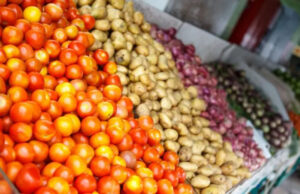Farmers share consumer prices
Farmers Receive Only One-Third Payment
Farmers’ Share of Consumer Prices
A recent study by the Reserve Bank of India (RBI) reveals that farmers receive only a fraction of what consumers pay for vegetables and fruits. The analysis focuses on three major vegetables: tomatoes, onions, and potatoes (commonly referred to as TOP). According to the findings, farmers are receiving approximately 33% of the consumer price for tomatoes, 36% for onions, and 37% for potatoes. This means that wholesalers and retailers are taking home nearly two-thirds of the total payment made by consumers.

Detailed Breakdown of Shares
The RBI’s research extends beyond just the TOP vegetables. It estimates that farmers’ shares in the consumer rupee are around 31% for bananas, 35% for grapes, and 43% for mangoes in the domestic value chain. Interestingly, the export value chain presents a different scenario; while mangoes yield a higher share for farmers, grapes see a reduced share despite offering higher realized prices compared to the domestic market.
This disparity highlights the inefficiencies present in the agricultural supply chain. In contrast to sectors like dairy, where farmers receive about 70% of the final retail price, the vegetable market shows significant discrepancies in price distribution.
Pulses vs. Vegetables
The RBI study also evaluated the consumer rupee spent on pulses. For example, approximately 75% of the money spent on gram (chana) returns to farmers, while the figures are around 70% for moong and 65% for tur. This indicates a more favorable economic structure for pulses compared to the TOP vegetables, where farmers struggle to obtain a fair share of consumer spending.
Challenges in the Value Chain
One of the major challenges highlighted in the study is the inefficient value chain for TOP vegetables. Unlike the well-developed procurement and marketing systems for cereals and dairy products, the distribution of tomatoes, onions, and potatoes suffers from multiple issues. These challenges stem from the perishable nature of these crops, their seasonal and regional concentration, inadequate storage facilities, and the large number of intermediaries involved in the supply chain.
The COVID-19 pandemic further exposed these bottlenecks. During the nationwide lockdown in 2020, many farmers were forced to discard crops or sell them at distress prices due to the sudden market disruptions. Conversely, consumers faced increased prices during lean seasons, reflecting the systemic inefficiencies in the market.
Addressing Market Inefficiencies
The study conducted by Gulati and Saini in 2013 stressed the need for enhanced supply responses and a correction of supply chain anomalies. They suggested that significant investments in agricultural research and development (R&D) could help in areas such as high-yielding seed varieties, irrigation, logistics, and processing plants. Another study by Ganguly and Gulati in the same year pointed out that rising prices for high-value commodities, driven by increased demand, could be mitigated through streamlined supply chains.
The Importance of TOP Vegetables
Tomatoes, onions, and potatoes play a crucial role in both production and consumption within the Indian agricultural sector. There has been a remarkable increase in the production of these crops over recent years. In the 2022-23 season, the production figures for these vegetables were significant: 20.4 million metric tons (MMT) for tomatoes, 30.2 MMT for onions, and 60.1 MMT for potatoes.
India has emerged as a global leader in the production of these crops, contributing 11% of the world’s tomato production and 15% of the global potato output in 2022. Furthermore, India overtook China in 2021 to become the largest onion producer and maintained this position with a 28.6% share of global production in 2022. The sharpest increase in production was observed in onions, which saw a staggering growth of 63% from 2013-14 to 2021-22.
Conclusion
The RBI’s findings shed light on the stark realities faced by farmers in India, who receive a mere third of what consumers pay for essential vegetables like tomatoes, onions, and potatoes. The significant share retained by wholesalers and retailers indicates a pressing need for reforms in the agricultural supply chain. By addressing these inefficiencies and investing in better systems, there is potential to improve farmers’ earnings and ensure fair pricing for consumers.
Disclaimer: The views expressed in this article are based on the findings of the RBI study and do not necessarily reflect the views of the publication.
